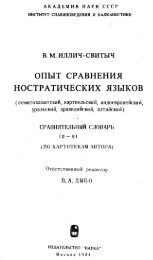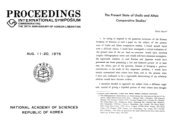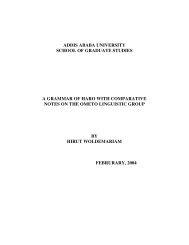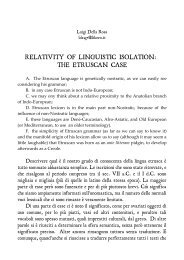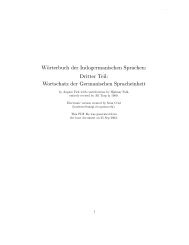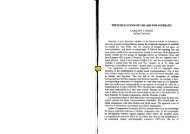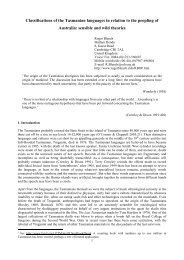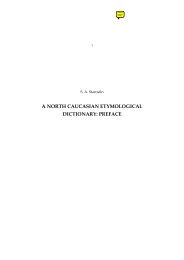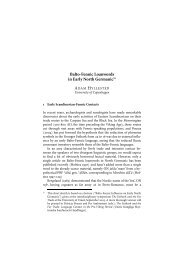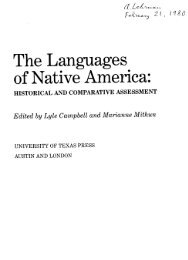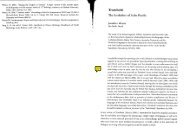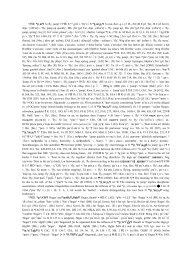The Indo-European Elements in Hurrian
The Indo-European Elements in Hurrian
The Indo-European Elements in Hurrian
Create successful ePaper yourself
Turn your PDF publications into a flip-book with our unique Google optimized e-Paper software.
5. Pronouns, Numerals, Adpositions, Conjunctions, Adverbs 55<br />
36 [1939]:23), who had previously analyzed Mâri 6.13 as ‘we together’. This<br />
means that this base šat- has noth<strong>in</strong>g to do with P1. This analysis is confirmed by the follow<strong>in</strong>g<br />
sentence <strong>in</strong> KBo 32.13 Ro I 9-10:<br />
- < d IM-ub ša-at-ta ¯a-mu-u-ra šu-úr-ru-ú ><br />
- <br />
‘9. Teššub together with Àamu 82 went 10. (to) the dark ground below’.<br />
<strong>The</strong> underly<strong>in</strong>g Proto-<strong>Hurrian</strong> personal pronouns are:<br />
First Person Second Person<br />
S<strong>in</strong>gular *i *bi<br />
Plural *i-lla *bi-lla<br />
<strong>Hurrian</strong> Personal Pronouns and <strong>Indo</strong>-<strong>European</strong> Parallels<br />
Turn<strong>in</strong>g to <strong>Indo</strong>-<strong>European</strong>, we f<strong>in</strong>d the follow<strong>in</strong>g (the <strong>Hurrian</strong> material is cited <strong>in</strong> the<br />
form given <strong>in</strong> Laroche’s Glossaire and Friedrich 1969a):<br />
1. <strong>Hurrian</strong> first person s<strong>in</strong>gular personal pronoun stem: Absolutive s<strong>in</strong>gular (ište) and Ergative<br />
s<strong>in</strong>gular (išaš). It is clear that the stem here is iš- (Diakonoff—Starost<strong>in</strong> 1986:81 reconstruct<br />
a common Hurro-Urartian *"ez-) to which case end<strong>in</strong>gs have been added. Perhaps a further<br />
analysis is possible — the stem may, <strong>in</strong> fact, be a compound: *i+šu. šu, <strong>in</strong> turn, is none<br />
other than the stem found <strong>in</strong> the other cases: Gen. sg. šowe, Dat. sg. šowe, Allat. sg. šuta,<br />
Comit. sg. šura, Equat. sg. šonna. In Proto-<strong>Indo</strong>-<strong>European</strong>, the paradigm of the first person<br />
personal pronoun is also suppletive — the Nom<strong>in</strong>ative s<strong>in</strong>gular has one stem, while the<br />
rema<strong>in</strong><strong>in</strong>g cases are built on an entirely different stem (*me-). <strong>The</strong> evidence from the<br />
daughter languages po<strong>in</strong>ts to several possible reconstructions for the first person personal<br />
pronoun (Nom. sg.): *H÷eĝ (cf. Gothic ik); *H÷eĝoH (cf. Lat<strong>in</strong> ego; Greek dãþ); *H÷eĝoHm<br />
(cf. Homeric dãþí; Laconian dãþíç); *H÷eĝhom (cf. Sanskrit ahám; Avestan azəm); *H÷e$<br />
(cf. Latvian es; Lithuanian àš [Old Lithuanian eš]; Armenian es); *H÷eĝom (cf. Old Church<br />
Slavic azъ). This seems to <strong>in</strong>dicate that this stem is a relatively late formation (though old<br />
enough to be represented <strong>in</strong> Hittite) and that it is composed of several deictic elements strung<br />
together. <strong>The</strong> first element is *H÷e-, to which *$- or *ĝ- or *ĝh- has been added, followed by<br />
*-oH or *-om (this analysis was first proposed by Karl Brugmann). It is the first element<br />
(*H÷e-) that may be compared with <strong>Hurrian</strong> *i- (< *H÷e-), the form extracted above from the<br />
analysis of iš- as *i+šu.<br />
2. <strong>Hurrian</strong> second person personal pronoun stem we- ‘you’ (Friedrich 1969a:15 writes *„e-):<br />
Compare the Proto-<strong>Indo</strong>-<strong>European</strong> second person personal pronoun stem *we(-s)-/*wo(-s)-,<br />
82<br />
«Àamu serait un autre nom de Tašmišu, frère et conseiller avisé de Teššub» <strong>in</strong> Catsanicos (1996:226). Cf. Haas,<br />
V. (1996:332 and 473).



